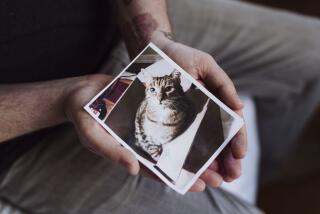For Some, a Photo Doesn’t Do It : Pets: Finding it hard to let go of Spot--or Fido or Fluffy? You’re not alone. Taxidermists say their business is booming.
- Share via
Doodles doesn’t claw the furniture anymore. She doesn’t hiss at strangers or meow when she wants to be fed. In fact, Doodles never stirs from a pillow near the fireplace in her Reston, Va., home.
That’s because Doodles’ owner, Jim Gottlieb, had her stuffed after the cat’s death last year.
“Today you can pet her and look at her and she won’t bite you,” said Gottlieb, 35, who cared for the temperamental seal-point Siamese for five years. Now he confesses to sometimes preferring the present-day Doodles to the real thing.
Although many people say they’d never dream of stuffing a treasured animal after it dies, taxidermists say they’re swamped with calls from bereaved owners eager to hold onto their pets.
“It’s really increasing in popularity,” said Greg Crain, executive director of the Louisiana-based National Taxidermy Assn. “Having a pet mounted is very much like a photograph or a painting, only it’s much more personal.”
*
Take Tweety, for instance.
For eight years, the green and yellow parakeet enjoyed free rein in Jim and Roxieann Brotherton’s Falls Church, Va., living room, flying in and out of his cage whenever he pleased.
When the bird died in August, Roxieann, 54, was devastated. As a surprise, Jim spent $400 to have the bird mounted on a small perch. Today Tweety sits--as if poised to sing--on top of an end table.
“I know it sounds silly, but I talk to him sometimes,” Roxieann said, “and every once in a while, tears come to my eyes.”
It sounds anything but silly to Kathy Reiter, a psychiatric social worker who runs support groups for bereaved pet owners and has counseled more than 12,000 clients.
Although taxidermy may not appeal to everyone, Reiter said it’s a natural solution for those who want to preserve memories of their pets.
“For those people who’ve had the animal with them for 10 to 15 years, [taxidermy] is a tribute,” Reiter said.
But Reiter said taxidermy can backfire. Instead of being a comfort, the inanimate animal can become a painful reminder of loss.
Although working on pets can be lucrative, most taxidermists are reluctant to get embroiled with distraught pet owners and shy away from working on domesticated animals.
When they do agree to handle one, most taxidermists charge plenty. The bill for a cat or dog can run $600, although a really big dog such as a Saint Bernard might cost several thousand dollars to mount.
“Usually when people call, the pet has just died, and they’re really, really upset,” said Brian Price, 38, who runs a taxidermy business in Vienna, Va., and has mounted his share of cats, birds and rabbits--even a pet wallaby. “I tell people to put their animal in the freezer, think about what they’re about to do and call me in a couple of weeks. They usually go through their grieving and don’t call back.”
Many animal-rights activists who oppose the preservation of animals killed for sport do approve of mounting pets.
“It may not be everyone’s idea of good taste, but if people want to stuff their pets and display them in their living rooms to show their love and respect for that animal, then we don’t have any problem with it,” said Leslie Gerstenfeld, a spokeswoman for People for the Ethical Treatment of Animals.
More to Read
Sign up for Essential California
The most important California stories and recommendations in your inbox every morning.
You may occasionally receive promotional content from the Los Angeles Times.













